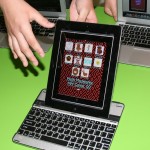Bullis Charter School Students Design Apps
By Martha Sessums, with a repost from Valerie Liberty, Head Chef, Wow! Division of Balsamiq Studios
Today’s educational experience should be about reading, writing, science, technology, engineering and math. And there’s an app for that — created by students.
Bullis Charter School’s 8th grade class created apps to help solve some of their problems, all part of an application design project. Using iPads that are part of their ACE Partnership School program, the students coded, tested, recoded, retested, then presented their apps at a Road Show at Googleplex. Below is the post from Valerie who helped support the program.
Oh, and I want the app that makes time management fun!
App Design for 8th Graders
Repost from March 14, 2003 by Valerie Liberty at Balsamiq Studios
On the same day my 14-year old son was inspired by this video about how everybody–including kids– should learn to code, I got an email from Bullis Charter School inviting me to meet a class of 13-year olds learning about Application Design. Co-teachers, Jessica Lura, Roxanne Lanzot and 25 kids completed the entire life cycle development for educational iPad apps. The curriculum included brainstorming, ideation, UX research, and wireframing with Balsamiq Mockups. They incorporated feedback, coded things up, and put on a Road Show at the Googleplex. They even found and reported a bug for us, resulting in this video response from Stefano! I can hear all my nerd-parent friends groaning with jealousy!
Like most of us using technology to solve real problems, these kids started their app development process by looking for answers to their own (enchanting) problems:
- The school choir is open to 3rd-8th graders. How can we help the 3rd graders learn to read music faster?
- Some 5th graders have trouble mastering state history standards;
- What else was going on around the world at the same time as important historical events we’re learning about?
- The kindergarten challenge of learning letters, numbers and colors;
- How to make time management fun so kids get to school on time.
After they mocked up their apps, they exported them to PDF, loaded them on iPads, and tested with younger kids during recess on the playground. So smart! I love it!
They incorporated feedback, prepared revisions, and coded in Corona SDK and Gimp to create working apps. The last piece of the week was the Dog & Pony show. A parent who works at Google arranged for a conference room, complete with free lunch! The kids were energized by the setting, and I was pleased to see such gracious corporate generosity.
The room was electric with excitement, families milling about beforehand. My favorite comment from a younger, 5th grade sibling was, “I can’t wait til I’m in 8th grade so I can learn to make applications, too!”
The teams hit some of the same bumps adult teams do: they had differing ideas, and didn’t always compromise easily. As I made my way around the room, I watched a demo by a lone student. When asked if the rest of his team was absent, he said, “No, I had a different idea of what I wanted an app to do. I asked my friends if they would be ok if I went off on my own to build something a little bit different, and they were fine with that. So I did.” I remain impressed with his confident, matter-of-fact explanation. It gives me hope that peaceful conflict resolution is part of elementary education. Imagine the impact on future software development and feature innovation with this kind of thinking!
No demos are complete without technical difficulties, and these girls won the first (but not only) “Grace Under Fire” award for keeping their cool. They weren’t rattled at all and gave a great preso.
Big thanks to the panel and volunteers who made this happen, including Chris Streeter, technical founder of Educreations (Their delightful motto is, “Teach what you know. Learn what you don’t.”) Laura Borns, founder of Cambridge Consultants LLC, UX agency, a real-life VC, and several hands-on coding fairies, dads who just want to share what they love with kids in their community.
Friends of Balsamiq, this is a completely repeatable formula. If you want to use Balsamiq Mockups to teach about UX and app design, please take a look at our free program details here.
If you are already using Balsamiq Mockups in a classroom, be sure you check out Leon’s new “Creating your First Mockup” tutorial here.
Be well, do well. Mock well. 🙂
Val


Thank you so much for sharing my blog post with our readers. I can’t stress enough the magical enthusiasm in the classroom from everyone: students and teachers, too. I look forward to watching what these kids share with us all. Marvelous innovation on deck!